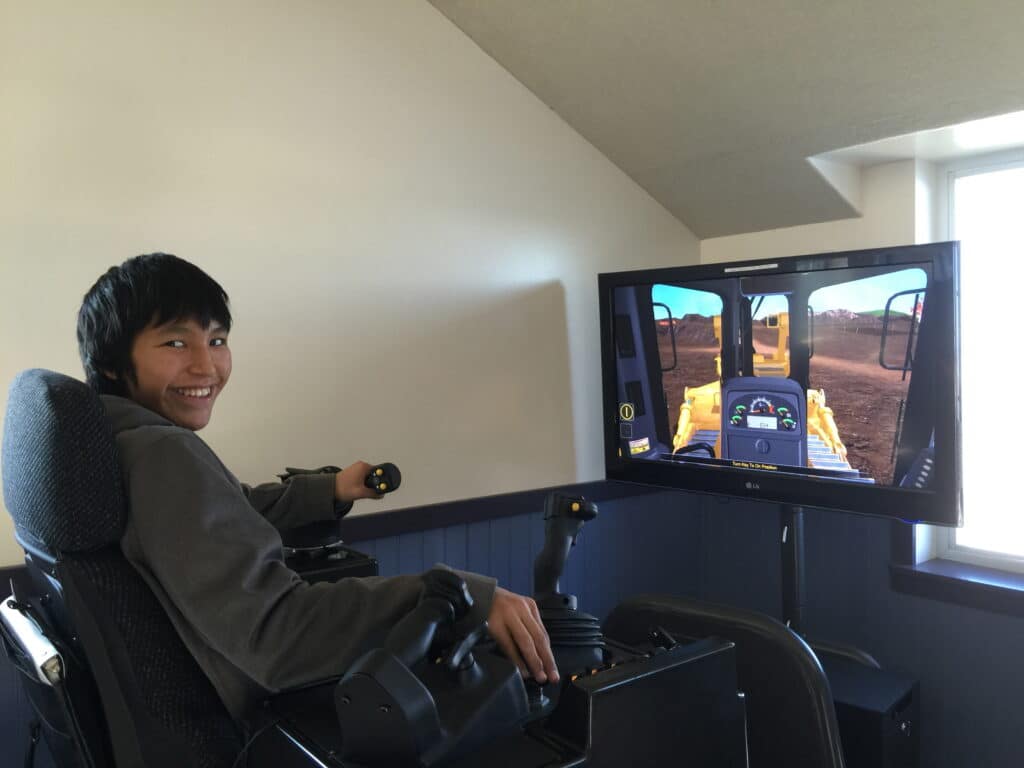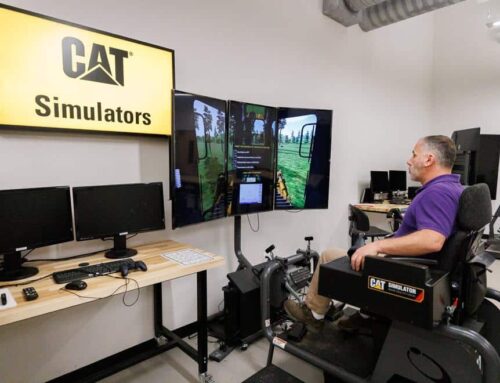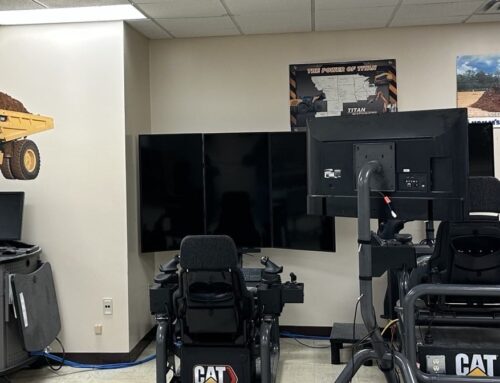Over the past five years, more than 1800 students have logged time on eight different Cat® Simulator models at the Northwestern Alaska Career and Technical Center (NACTEC) in Nome, Alaska. According to NACTEC Director, Doug Walrath, over 12% (229 students) have continued on to more advanced and focused training utilizing the simulators.
NACTEC operates in partnership with Bering Strait School District and Nome Public Schools, serving students across an 86,000 square mile region of Northwestern Alaska, an area the size of the state of Minnesota. NACTEC serves an integral role in a network of Regional Training Centers (RTCs) that comprise the backbone of vocational training across the vast expanses of rural Alaska. The RTCs are the foundation of Alaska’s Department of Labor and Workforce Development and support the goal to optimize in-region vocational education and training efforts that will prepare Alaskans for work across eight priority industries.
“Natural resource development and construction are two priority industries where NACTEC is using Cat Simulators to meet workforce training needs through our residential program in Nome,” explained Walrath.
Career exploration at NACTEC begins as early as junior high. Nationwide statistics show that 60-70% of student disengagement occurs in the 7th and 8th grades, making these years vitally important to engage students with experiences to explore different career tracks.
“The simulators have proven to be very effective tools to engage students,” Walrath said. “The interface is ‘teen friendly’ and appeals to 21st century learners.”
The Center offers two-week programs over the course of the school year covering a range of vocations. Students fly in and stay on campus where they participate in training relevant to their vocational track as well as sessions focused on career skills (resume writing, interviewing, etc.) and personal development/life skills.
“Junior high students attend NACTEC for four days,” explained Brian Volk, CTE Teacher/Heavy Equipment Lead Instructor. “Knowing that their time is limited, they are constantly asking for simulator time and scrambling to get into the seats. Each machine will be occupied for as long as time is allotted.”
A growing program
Simulators were added to the program in 2011 and include machine models that have the greatest relevance to the industry needs in Northwestern Alaska. The Cat Simulators Center at NACTEC currently includes the Hydraulic Excavator, Track Type Tractor, Motor Grader, Small and Large Wheel Loaders, Off-Highway Truck, Mining Truck, and Articulated Truck.
During NACTEC’s start-up years (2004-2009) enrollment averaged 241 students per year across all training programs. Since then enrollment has increased by 66% with an average of 400 trainees per year in the past five years. They have also seen a 21% increase in high school enrollment of junior high students who have completed a weeklong residential program in 8th grade.
“The simulators and the availability of training certainly serve a role in the increased student engagement,” said Walrath. “First time students excitedly seek opportunities to train on the heavy equipment simulators.”
In 2012 a new training program focused on a career as a heavy equipment operator was added to NACTEC’s offering of 25 vocational specific training programs. By 2014 the program evolved to include maintenance and mechanic training elements to better prepare future operators with preventative maintenance basics and essential skills.
Maximizing student access to the simulators and their exposure to the heavy equipment industry was a key goal when NACTEC first introduced the simulators to the program. That’s why the decision was made to house the simulators outside of the classroom and more central to the students’ residential area.
On the first day of the training program, and regardless of the field a student is enrolled, everyone receives introductory training on the simulators, along with their own login and password combination unique to SimU Campus™ (the software that measures, records and reports the results of all simulation sessions) for individual digital training portfolios.
After giving students an orientation on the simulators covering login, basic trouble-shooting and safety, students are free to train on the simulators whenever they have the opportunity to do so. The Open Training exercise is popular with students as it allows them the freedom to maneuver and explore the simulation. Sometimes they enjoy getting into tricky or challenging situations, which helps them sense the limitations and learn how to appropriately handle the different machines.
“Students in career exploratory mode may use the simulators during recreation time for as few as 2-5 hours per two-week training program, while more interested and advanced students may invest 30-40 hours or more of training time in a specialized program,” explained Walrath.
Based on the initial success of Heavy Equipment Operator training, NACTEC has expanded simulator-based workforce development training to now include maritime, welding, and aviation applications.
“As an instructor, it never gets old watching students on the simulators,” Volk said. “They have a blast every time they’re on them and it is really neat being able to learn alongside them.”
Building skills for tomorrow and for today
Experienced heavy equipment operators note the importance of time spent on controls familiarization as a necessity for efficient and effective operation. That’s why this is one of the first areas where students receive training. For those who move into careers as equipment operators, time spent on the simulators will positively impact the transition to the operator’s seat in the dirt, snow, or – in the case of off-shore gold mining – on the waters around Nome.
“I have introduced the simulators to local heavy equipment operators who are working for the DOT and mining industry, “said Volk. “They are amazed with the realism and accuracy of the programs.”
Volk also uses the reporting features built into the simulators as a teaching opportunity with his students.
“I share the data to show students how much time they have logged on each simulator and how much fuel they have used,” he explained. “The more often students attend NACTEC, the more their record of experience on the simulators will grow.”
Based on the number of hours accrued on the simulators, students can earn a Heavy Equipment Certificate when they graduate that they can then show prospective employers.
“Heavy equipment operation is an integral part of everyday life in rural Alaska –from airport and road maintenance to large scale mining and oil production,” said Volk. “Many students have parents and other family members working in these industries. The simulators give students confidence and motivation to pursue similar career paths.”
While many students are using the simulators to help direct future career choices, many students are also using the simulators to gain a skill that benefits them right now – driving. Residents in the 15 villages surrounding Nome utilize four-wheelers, snow mobiles and dog sleds for ground transportation. These remote villages can only be accessed via airplane or boat. Automobiles are non-existent, or limited to only one or two trucks in most villages. As a result, most students are not familiar with automobile controls such as a steering wheel, gearshift, and brake and accelerator pedals.
NACTEC’s Driver Education training is one of the few remaining high school driver’s education programs in Alaska and its most “in-demand” course. NACTEC received State of Alaska approval as a third-party examiner to administer road tests and license young drivers. The simulator center has become an important element of the driver education training. Since the mining truck and off-highway truck simulator systems are equipped with actual machine controls – including a steering wheel and brake pedals – these two simulators are being used for driver education training.
“As students attain their initial driver’s license, a more focused career intensive training guides students deeper into heavy equipment operator training as a career pathway,” said Walrath.
Looking to the future
Both Walrath and Volk see growth on the horizon for NACTEC. By 2017 they plan to have full motion-based platforms across their line of Cat Simulators. By 2021 the vision is that NACTEC will serve an integral role in training operators to meet the workforce development needs across Alaska’s construction, mining, and oil & gas industries.
Career exploratory training with high school students will remain a focal point, with increased local industry outreach efforts. Such partnerships and training will better situate the organization to prepare novice learners with prerequisite skills and knowledge as beginning operators.
NACTEC is also beginning a three-year partnership with AVTEC: Alaska’s Institute of Technology through a secondary to post-secondary vocational training bridge program. NACTEC students who complete heavy equipment training are connected with AVTEC’s Diesel/Heavy Equipment Technologies program. During this weeklong transition program high school students from Northwestern Alaska travel to Seward to “shadow” an AVTEC student while becoming fully immersed in the Diesel/Heavy Equipment program.
“The hands-on approach to AVTEC’s Diesel/Heavy Equipment Technologies program helps students learn how to service, maintain, and repair equipment ranging from semi-trucks to bulldozers,” said Walrath. “Broadening their experience in these skills will develop the ideal rural Alaskan worker – one who can maintain, operate and repair their machine in severe weather conditions.”
“I feel like we are on the cutting edge of relevant training in Career and Technical Education and Cat Simulators are a focal point,” said Volk. “Alaska is an exciting place to work and live and heavy equipment operator skills are highly desired. For many of our students who are not interested in college, this is a very realistic option.”







